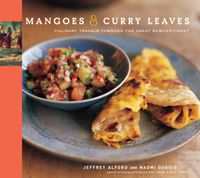🔥 Celebrate new books on our BBQ & Grilling shelf with 25% off ckbk membership 🔥
Rebirth
By Jeffrey Alford and Naomi Duguid
Published 2005

A Hindu shrine near Darbar Square in Kathmandu. People come at all hours to pray and make offerings; they ring the bell when the offering is made.
I was heading to the dry mountain valleys of Ladakh, also known as “Little Tibet,” north of the Himalaya, in those days newly opened to foreign travelers. I reached Leh, the Ladakhi capital, in early June, after a two-day bus ride from Srinagar. A week later, I headed farther east along the Indus Valley to Hemis gompa (gompa means “monastery”), where the big annual mela, or “festival,” was about to start. Buses and trucks loaded with pilgrims made their way up the rocky road to the gompa. People found places to camp on the hillsides, by the streams, wherever they could find a piece of open ground. I set up my tent not far from the gompa, then went to look around. Small tea stalls, and stands selling momos (boiled meat-filled dumplings) and simple noodle stews called thugpa, were doing good business near the entrance, feeding the throng. Butter lamps (small bowls filled with melted butter, with a wick in the center) were lit inside the Tibetan-style temple, and the smoke from offerings of dried juniper perfumed the air. It’s the closest I’ve ever been to a medieval religious festival, both a holiday and a pilgrimage.
Become a Premium Member to access this page
Unlimited, ad-free access to hundreds of the world’s best cookbooks
Over 150,000 recipes with thousands more added every month
Recommended by leading chefs and food writers
Powerful search filters to match your tastes
Create collections and add reviews or private notes to any recipe
Swipe to browse each cookbook from cover-to-cover
Manage your subscription via the My Membership page
Part of
Advertisement
Advertisement


